When looking for the best XLR microphones for professional audio recording, you’ll find a wide variety to choose from. The MAONO XLR Podcast Microphone, FIFINE Dynamic Microphone, and Shure MV7X are all worthy contenders, offering features like cardioid polar patterns, durable metal bodies, and versatile connectivity. Considering factors like frequency response, noise rejection, and included accessories can help you select the right XLR mic to elevate your audio quality. To dive deeper into the 15 best options, keep reading.
Key Takeaways
- XLR microphones offer superior audio quality and noise rejection, making them ideal for professional audio recording applications like podcasting, voiceovers, and music production.
- Cardioid polar pattern is a common feature in XLR microphones, allowing them to focus on the primary sound source while rejecting off-axis noise and background interference.
- Robust, all-metal construction and sturdy shock mounts ensure XLR microphones can withstand the rigors of professional use, delivering reliable performance over an extended lifespan.
- XLR microphones require higher impedance and may need an audio interface or preamp to operate optimally, providing more control over gain, EQ, and other audio parameters.
- Popular XLR microphone models like the Shure SM58, Rode NT1, and Audio-Technica AT2020 are widely used in professional audio settings due to their exceptional sound quality and versatility.
MAONO XLR Podcast Microphone for Vocal Recording and Streaming
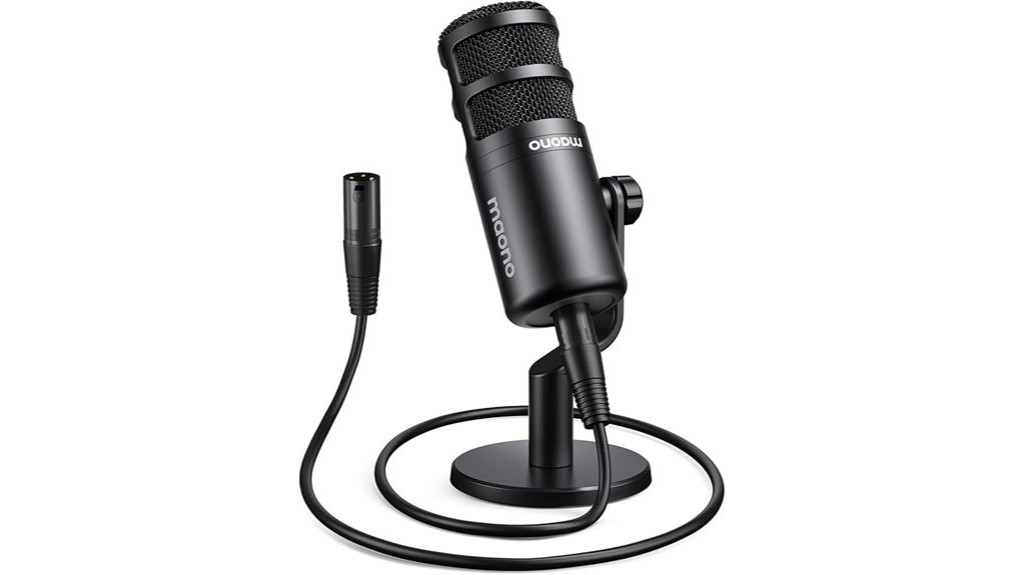
If you’re looking for a professional-grade XLR microphone focused on vocal recording and streaming, the MAONO XLR Podcast Microphone is an excellent choice. With its cardioid studio dynamic design, it delivers clean and mellow audio across a 60-14kHz frequency range. The “Talk to the Mic Top” pick-up technology guarantees smooth and detailed voice capture. The metal body’s sleek, compact, and portable design includes a 2.36-inch rod extender and a heavy, round metal base for stability. It connects via XLR for use with audio interfaces, mixers, and sound cards, providing clear, professional-quality sound for voiceovers and podcasts. While it requires gain boost and EQ tuning for ideal performance, the MAONO XLR Podcast Microphone offers a plug-and-play setup and good noise and background rejection.
Best For: The MAONO XLR Podcast Microphone is best for vocal recording, streaming, voice-overs, and podcasting.
Pros:
- Delivers clear, professional-quality sound
- Easy plug-and-play setup
- Good noise and background rejection
Cons:
- Requires gain boost and EQ tuning for optimal performance
- Not suitable for music recording or instrumentation
- More expensive than USB microphones
https://www.amazon.com/dp/B0BC3XB26X
FIFINE Dynamic Microphone for Vocal Recording and Streaming (K688)
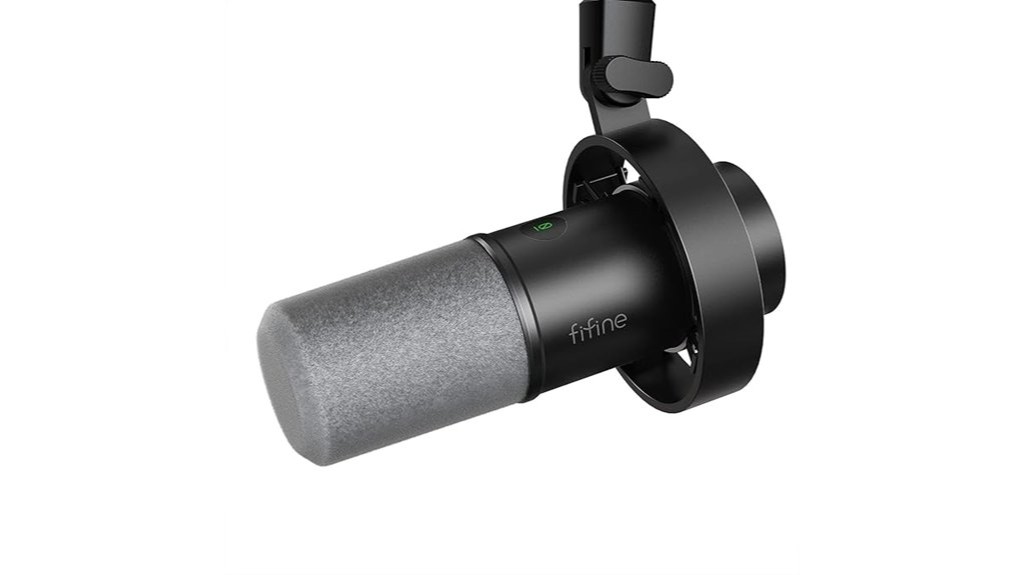
For those seeking a versatile and high-quality dynamic microphone for vocal recording and streaming, the FIFINE Dynamic Microphone for Vocal Recording and Streaming (K688) stands out as a compelling choice. It boasts a clean sound quality with a 130dB SPL to prevent distortion, and its cardioid pattern helps mitigate background noise. The included windscreen and shock mount effectively reduce plosives and low-frequency vibration, ensuring clear, natural audio. With dual XLR and USB connectivity, it’s compatible with a wide range of devices, and the plug-and-play USB connection makes setup a breeze. The headphone jack and volume control knob allow for real-time monitoring, while the mute button offers quick muting.
Best For: The FIFINE Dynamic Microphone for Vocal Recording and Streaming (K688) is best for users seeking a versatile and high-quality dynamic microphone for vocal recording and streaming.
Pros:
- Clean sound quality with 130dB SPL to avoid distortion
- Cardioid pattern deals with background noise
- Included windscreen and shock mount to reduce plosives and low-frequency vibration
Cons:
- No information on battery life or power source for the microphone
- No details on the type of XLR or USB connectivity
- No specifications on the headphone monitoring capabilities
https://www.amazon.com/dp/B0B8SNVK5K
MAONO XLR/USB Dynamic Microphone Kit for Streaming, Gaming, Voice-Over, Recording (PD200XS Black)
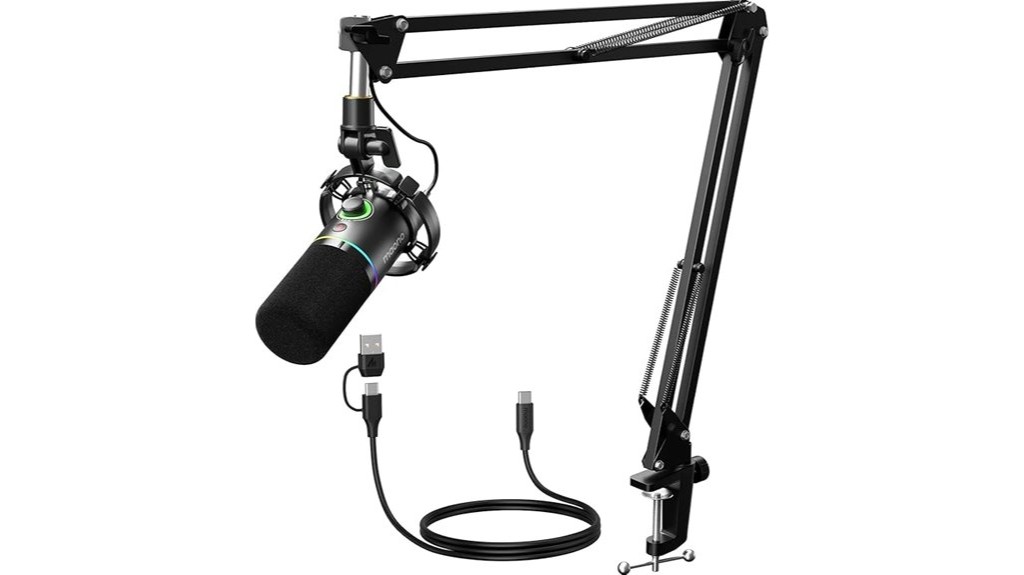
The MAONO XLR/USB Dynamic Microphone Kit is an excellent choice for streamers, gamers, voice-over artists, and budget-conscious recording enthusiasts. It boasts a versatile USB and XLR dual interface, ensuring compatibility across various setups. The built-in noise reduction technology and impressive audio specifications, including a 40Hz-16kHz frequency response and 80dB signal-to-noise ratio, deliver professional-grade sound quality. The kit’s impressive features, like the adjustable boom arm, RGB lighting control, and one-click mute function, make it a compelling option for content creators on a budget. Plus, Maono’s outstanding customer support adds value to this already feature-rich microphone kit.
Best For: The MAONO XLR/USB Dynamic Microphone Kit is best for streamers, gamers, voice-over artists, and budget-conscious recording enthusiasts.
Pros:
- Versatile USB and XLR dual interface
- Impressive audio specifications and noise reduction technology
- Feature-rich with adjustable boom arm, RGB lighting control, and one-click mute function
Cons:
- May not have the same audio quality as higher-end professional microphones
- Requires additional software for advanced customization
- The boom arm may not be suitable for all desk setups
https://www.amazon.com/dp/B0CN493YHF
FIFINE USB/XLR Dynamic Microphone for Podcast Recording
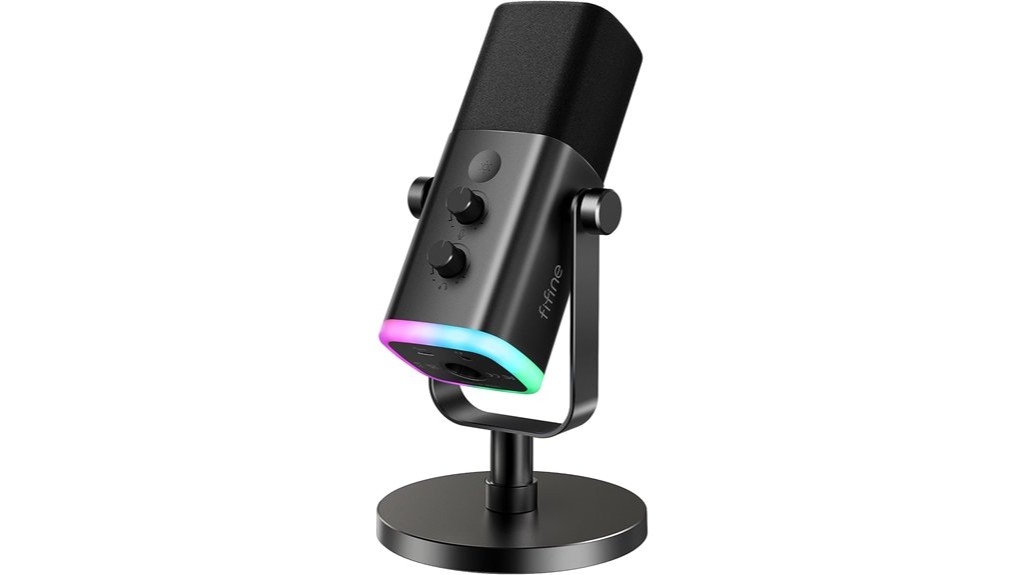
Podcasters seeking a versatile and affordable XLR microphone will find the FIFINE USB/XLR Dynamic Microphone an enticing choice. Its cardioid polar pattern rejects off-axis noise, ensuring your voice takes center stage. With a frequency response of 50Hz-16kHz, you’ll enjoy a balanced audio range. The XLR and USB connectivity offer compatibility with studio equipment and plug-and-play simplicity. Plus, the tap-to-mute button and smooth gain knob give you control over your recordings. Complement your setup with the configurable RGB ring and sturdy metal construction compatible with most mic stands. Whether podcasting, streaming, or gaming, the FIFINE delivers professional-quality audio without breaking the bank.
Best For: Podcasters, streamers, and content creators looking for an affordable, versatile XLR microphone with professional-grade audio quality.
Pros:
- Cardioid polar pattern rejects off-axis noise for clear, focused audio
- Frequency response of 50Hz-16kHz for a balanced, detailed sound
- Flexible XLR and USB connectivity options for compatibility with various setups
Cons:
- Limited to a 50Hz-16kHz frequency range, which may not be suitable for some applications
- No included shock mount or pop filter, which may need to be purchased separately
- Some users may find the gain knob and tap-to-mute button a bit finicky
https://www.amazon.com/dp/B0BMFQP2ZZ
Shure MV7X Microphone for Podcasting & Vocal Recording
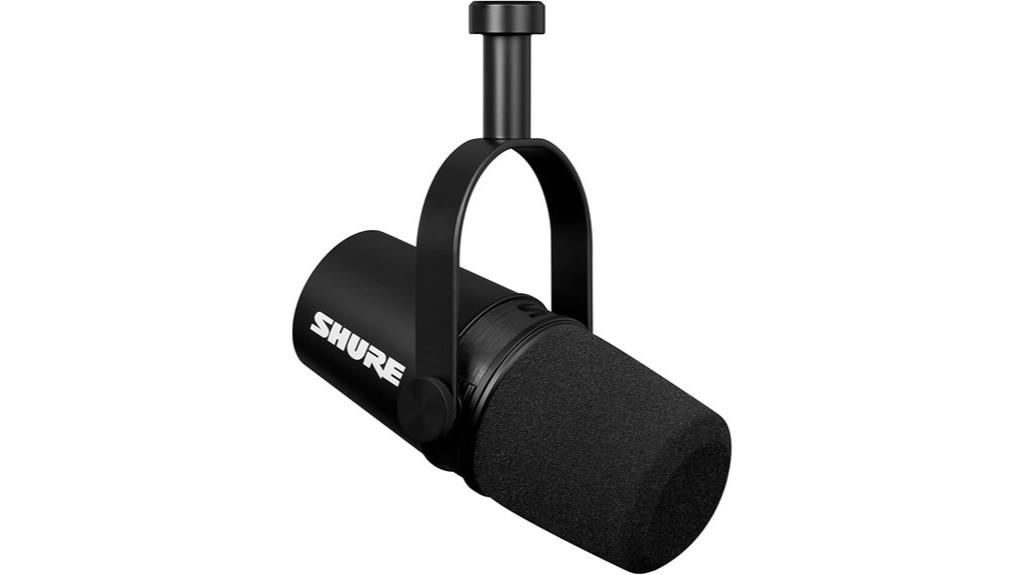
Designed for crystal-clear vocal recordings, the Shure MV7X dynamic microphone is a top choice for podcasters and voice-over artists alike. Featuring voice isolation technology, this XLR mic delivers focused, professional-grade audio. Its durable all-metal construction guarantees long-lasting performance, while the large diaphragm provides excellent sensitivity and noise reduction. With a 16 kHz frequency response and 72 dB signal-to-noise ratio, the MV7X captures your voice with exceptional clarity. Easily integrating with audio interfaces and mixers, this mic offers plug-and-play convenience for a seamless recording experience. Backed by a 4.7-star rating from over 3,000 customers, the Shure MV7X is a versatile and reliable choice for your podcasting or vocal recording needs.
Best For: The Shure MV7X is best for podcasters, voice-over artists, and anyone seeking a high-quality dynamic microphone for clear, focused vocal recordings.
Pros:
- Excellent sound quality with voice isolation technology
- Durable all-metal construction for long-lasting performance
- Plug-and-play compatibility with various audio interfaces and mixers
Cons:
- Relatively large size may not be ideal for some desktop setups
- Heavier weight compared to some other podcast microphones
- Higher price point than some entry-level dynamic microphones
https://www.amazon.com/dp/B09BZZCGC8
NEEWER NW-040 Cardioid Dynamic Microphone
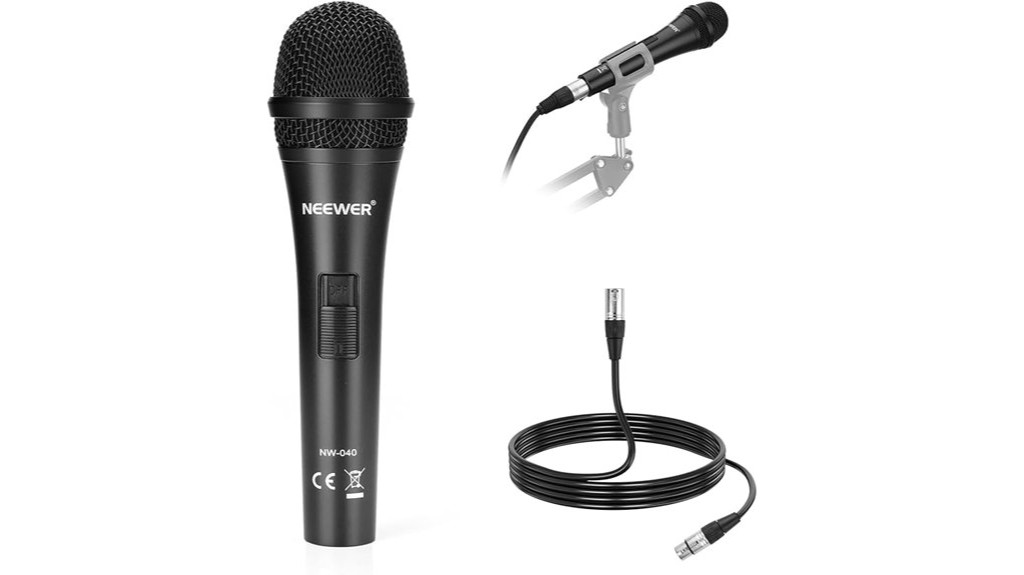
A versatile choice for professional-grade audio recordings, the NEEWER NW-040 Cardioid Dynamic Microphone packs an impressive array of features. Its advanced moving coil transducer and unidirectional cardioid polar pattern provide exceptional sound capture, while the rigid aluminum alloy housing confirms durability. With a frequency response that’s been extended for optimal performance, this microphone is well-suited for a variety of applications, from public speaking and singing to podcasting and voice acting. Plus, the included XLR cable makes it easy to integrate into your audio setup. Whether you’re a seasoned pro or just starting out, the NEEWER NW-040 is a reliable and affordable option for high-quality recordings.
Best For: The NEEWER NW-040 Cardioid Dynamic Microphone is best for professional-grade audio recordings, public speaking, singing, podcasting, voice acting, and musical instrument recording.
Pros:
- Advanced moving coil transducer and unidirectional cardioid polar pattern provide exceptional sound capture
- Rigid aluminum alloy housing ensures durability
- Versatile applications make it suitable for a variety of use cases
Cons:
- Higher impedance (600 Ohm) may require an audio interface or preamp for optimal performance
- Heavier weight (1.32 pounds) may not be ideal for portable/handheld use
- Some users may prefer a more affordable or feature-rich microphone for their specific needs
https://www.amazon.com/dp/B074HZFG3P
Shure SM58 Pro XLR Dynamic Microphone
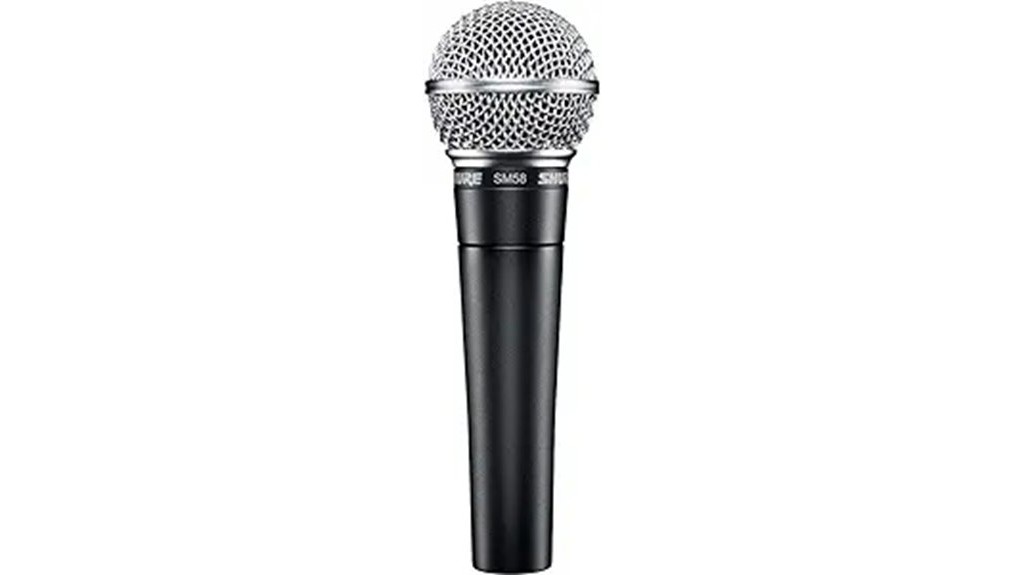
For the aspiring recording artist or seasoned professional, the Shure SM58 Pro XLR Dynamic Microphone stands as an industry-standard choice. Delivering high-quality vocal reproduction with its tailored frequency response and brightened midrange, this microphone is versatile for both live and studio use. Its uniform cardioid polar pattern guarantees every note is reproduced as intended, while the built-in pop filter and durable construction make it a reliable companion for tough performances. With an impressive 4.8-star rating from over 12,000 customers, the SM58 is praised for its exceptional clarity, vocal performance, and unmatched versatility across a wide range of applications.
Best For: The Shure SM58 Pro XLR Dynamic Microphone is best for vocalists, podcasters, and recording professionals who demand high-quality audio reproduction and durable construction for live and studio use.
Pros:
- Exceptional vocal performance with tailored frequency response and brightened midrange
- Uniform cardioid polar pattern for accurate note reproduction
- Durable and reliable construction for tough performances
Cons:
- Heavier than some portable microphone options
- May require additional accessories like a stand for optimal positioning
- Not wireless, requires an XLR connection
https://www.amazon.com/dp/B000CZ0R42
FIFINE USB/XLR Dynamic Microphone for Podcast Recording
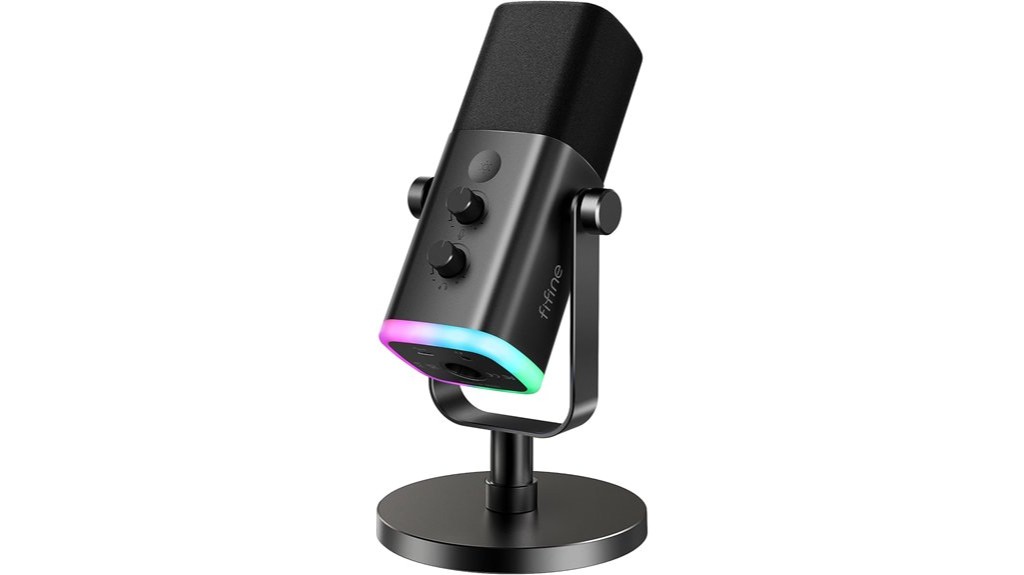
The FIFINE USB/XLR Dynamic Microphone is an excellent choice for podcasters and budding content creators who want professional-quality audio without the steep learning curve. Its directional cardioid design effectively rejects off-axis noise, ensuring your voice takes center stage. With a frequency response of 50Hz-16KHz, you’ll enjoy a balanced, natural-sounding recording. The flexible XLR and USB connectivity allow you to integrate this mic into your existing setup or use it as a plug-and-play solution. Convenient controls like the tap-to-mute button and smooth gain knob give you full command over your audio. The configurable RGB lighting and metal construction add a touch of style to your recording space.
Best For: The FIFINE USB/XLR Dynamic Microphone is best for podcasters, gamers, streamers, and singers who want professional-quality audio with a user-friendly setup.
Pros:
- Directional cardioid design effectively rejects off-axis noise
- Flexible XLR and USB connectivity for studio or plug-and-play use
- Convenient controls like tap-to-mute and smooth gain knob
Cons:
- Limited frequency response range compared to more expensive studio mics
- Potential compatibility issues with certain audio interfaces or software
- The built-in RGB lighting may not appeal to all users
https://www.amazon.com/dp/B0BMFQP2ZZ
FIFINE Dynamic Microphone for Podcast Recording and Streaming (K688)
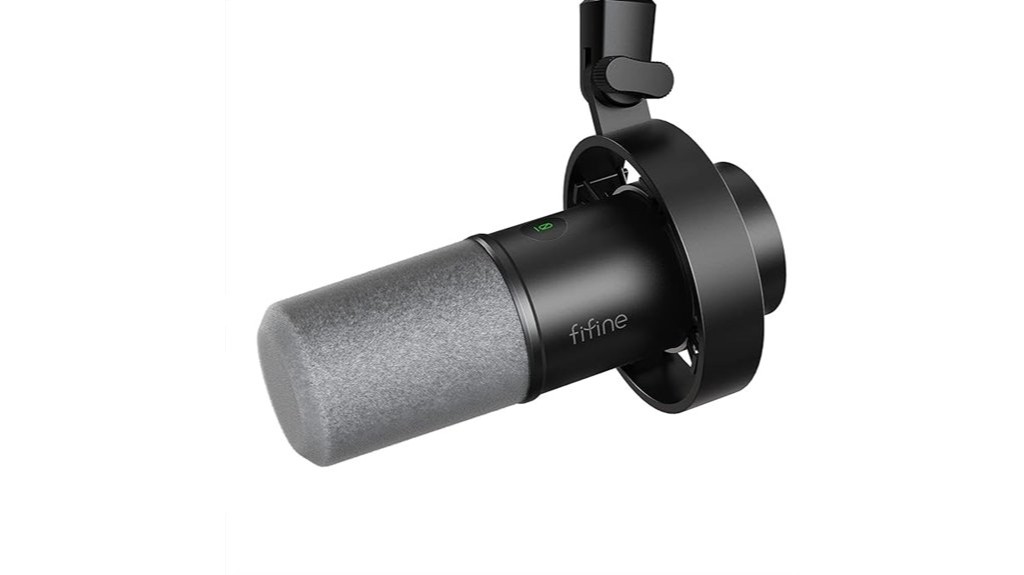
If you’re looking for a versatile and high-quality XLR microphone for podcast recording and streaming, the FIFINE Dynamic Microphone (K688) is a fantastic choice. Its clean sound quality, with a 130dB SPL, guarantees distortion-free recordings, while the cardioid pattern effectively deals with background noise. The included windscreen and shock mount further enhance the audio quality by reducing plosives and low-frequency vibrations. The dual XLR and USB connectivity make it easy to integrate into your setup, whether you’re using Windows, Mac, or other audio equipment.
Best For: The FIFINE Dynamic Microphone (K688) is best for podcast recording, streaming, and other audio applications that require high-quality, noise-reducing microphone performance.
Pros:
- Clean, distortion-free sound quality with 130dB SPL
- Effective cardioid pattern for background noise reduction
- Included windscreen and shock mount for improved audio quality
Cons:
- Relatively low signal-to-noise ratio (80 dB) compared to some higher-end microphones
- No rechargeable battery for portable use
- Limited controls, with only volume and mute functionality
https://www.amazon.com/dp/B0B8SNVK5K
FIFINE XLR/USB Gaming Microphone Set for Streaming and Podcasting
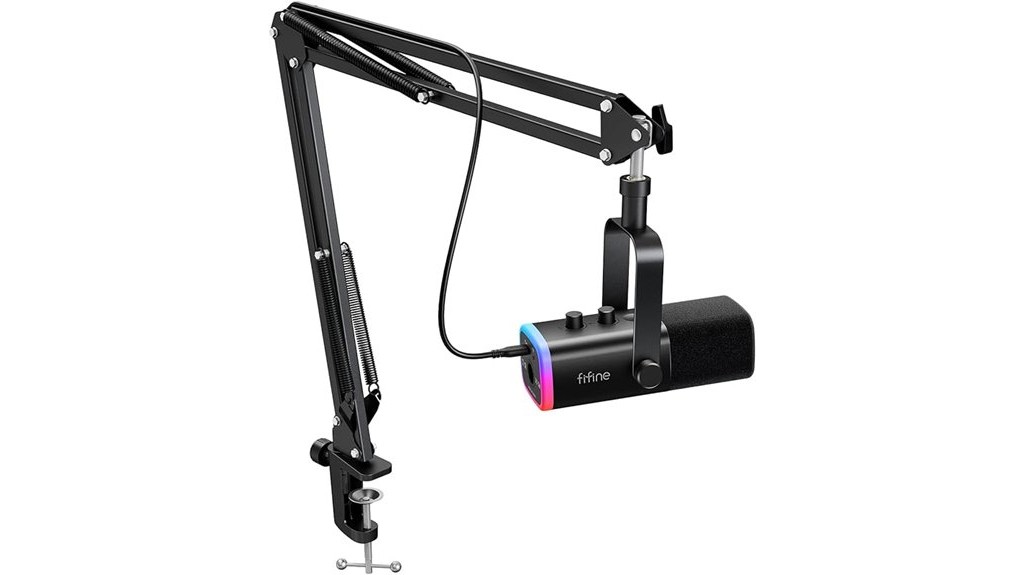
The FIFINE XLR/USB Gaming Microphone Set (AM8T) is an excellent choice for gaming enthusiasts and streamers seeking a versatile, high-quality microphone. Its dual connectivity options, via USB and XLR, provide the flexibility to use it directly with your PC or connect it to professional audio equipment. With a cardioid polar pattern and impressive 20kHz frequency response, this dynamic mic delivers clear, noise-reduced audio perfect for streaming, podcasting, and voiceovers. The customizable RGB lighting and sturdy, adjustable boom arm further enhance its appeal, while the mute button and volume control offer convenient control. Whether you’re gaming, broadcasting, or recording, the FIFINE XLR/USB Microphone Set guarantees your audio stands out.
Best For: Gamers, streamers, and podcasters seeking a versatile, high-quality microphone with customizable RGB lighting and professional audio capabilities.
Pros:
- Dual XLR and USB connectivity for flexibility
- Cardioid polar pattern and 20kHz frequency response for clear, noise-reduced audio
- Sturdy, adjustable boom arm with customizable RGB lighting
Cons:
- May require additional audio equipment (mixers, sound cards, etc.) for XLR use
- Relatively larger size compared to some desktop mics
- Learning curve for optimal audio settings and configuration
https://www.amazon.com/dp/B0C74GYW3J
XLR Podcast Microphone Professional Cardioid Condenser Microphone for PC
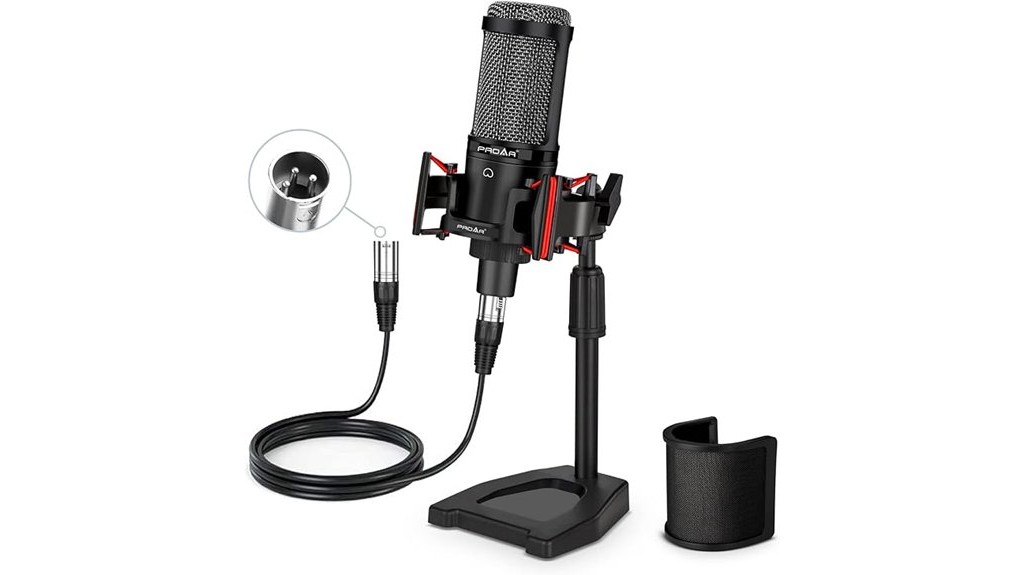
For those seeking a professional-grade condenser microphone for podcasting, streaming, and home studio recording, the XLR Podcast Microphone Professional Cardioid Condenser Microphone for PC offers exceptional audio quality and versatility. Featuring a large 14mm condenser capsule and a smooth, wide frequency response of 20Hz-20kHz, this microphone delivers crystal-clear, high-resolution audio. The cardioid pickup pattern effectively isolates the sound source in front of the mic, reducing noise from the surroundings. Sturdy metal construction and a weighted desk stand guarantee stability, while the included shock mount and pop filter enhance the overall sound quality.
Best For: Podcasters, streamers, and home studio enthusiasts seeking a professional-grade condenser microphone with exceptional audio quality and features.
Pros:
- Large 14mm condenser capsule and wide frequency response for crystal-clear, high-resolution audio
- Cardioid pickup pattern effectively isolates the sound source and reduces background noise
- Sturdy metal construction and weighted desk stand provide stability and vibration reduction
Cons:
- Requires 48V phantom power, audio interface, mixer, or preamp for operation (not included)
- May require additional accessories like mic stands or boom arms for optimal positioning
- Higher price point compared to some entry-level condenser microphones
https://www.amazon.com/dp/B0BF522C29
Phenyx Pro Dynamic Vocal Microphone
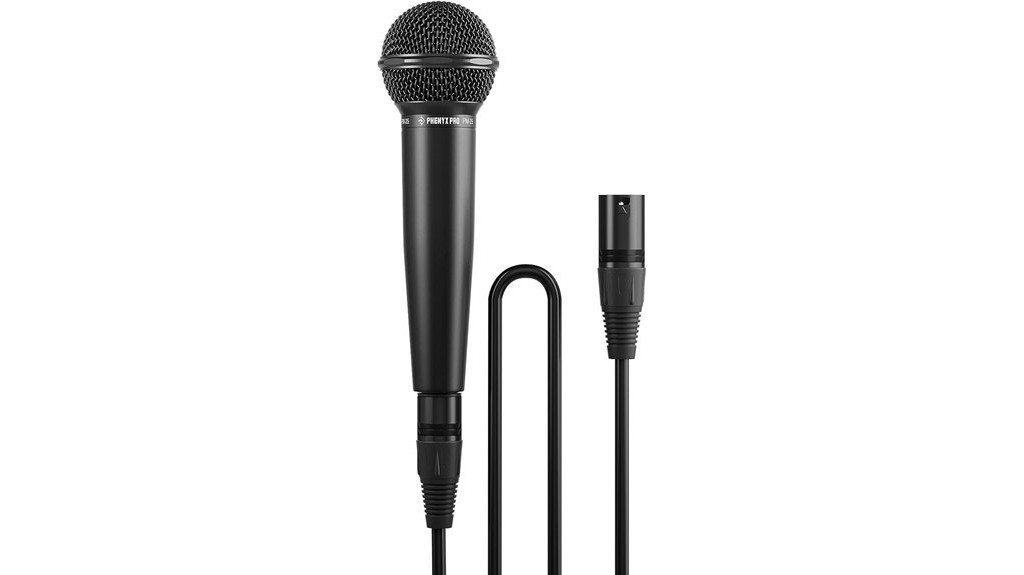
As a dynamic vocal microphone, the Phenyx Pro is the ideal choice for vocalists and performers seeking to capture the nuances and power of their voice. With its cardioid polar pattern, the mic minimizes ambient noise, while the built-in foam cover reduces plosives and sibilance. Its full-metal construction guarantees durability and reliability on stage or in the studio. Boasting a warm, full-bodied low-end and bright highs, the Phenyx Pro delivers a balanced, neutral tone with a wide dynamic range that preserves the soul and power of your voice. Plus, the included accessories, like the XLR cable and mic clip, make it a versatile and convenient option for any audio setup.
Best For: The Phenyx Pro Dynamic Vocal Microphone is best for vocalists and performers seeking to capture the nuances and power of their voice for live performances, recording studios, or karaoke.
Pros:
- Cardioid polar pattern minimizes ambient noise
- Built-in foam cover reduces plosives and sibilance
- Full-metal construction for durability and reliability
Cons:
- No on/off switch or mute function
- May not be suitable for extremely loud or high-volume applications
- No options for polar pattern or frequency response adjustments
https://www.amazon.com/dp/B0FFB747RT
TONOR XLR/USB Gaming Mic for Podcast Recording and Streaming (TD520S)
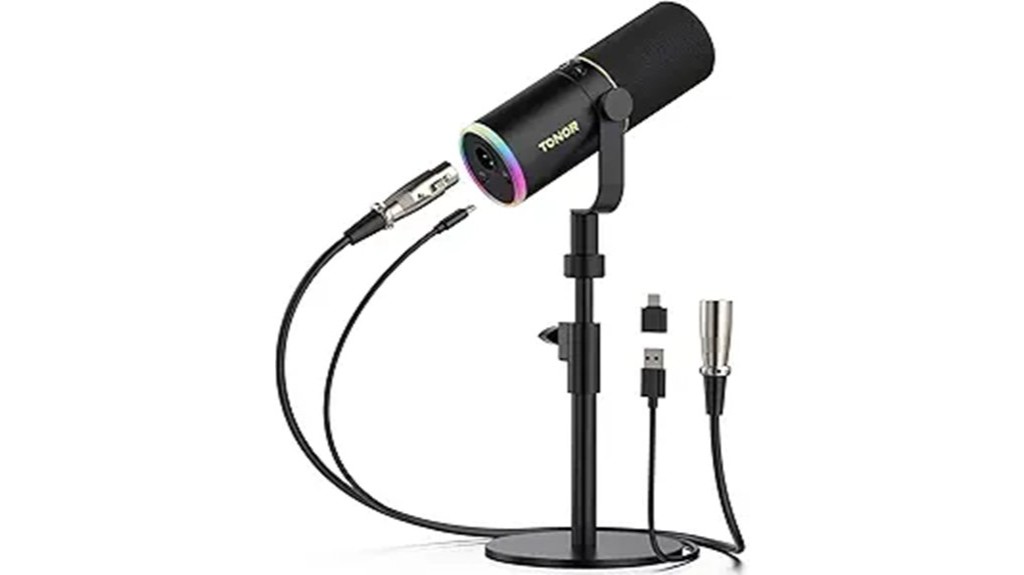
Aspiring podcasters and streamers looking to elevate their audio quality will find the TONOR XLR/USB Gaming Mic (TD520S) an excellent choice. Its dynamic core delivers impressive frequency response and sound pressure levels, while the cardioid polar pattern reduces background noise. The built-in noise reduction technology further enhances the clean, clear audio. You can connect the mic via USB for plug-and-play convenience or opt for the XLR interface for professional-grade analog signals. The all-metal construction and adjustable stand guarantee durability and versatility. Thoughtful features like RGB lighting, a mute button, and zero-latency monitoring make this mic a valuable tool for your content creation needs.
Best For: Aspiring podcasters and streamers seeking to elevate their audio quality with a versatile and feature-rich microphone.
Pros:
- Impressive frequency response and sound pressure level for high-quality audio capture
- Cardioid polar pattern and built-in noise reduction for clear, noise-free recordings
- Dual connectivity options (USB and XLR) for flexible integration with various setups
Cons:
- Recommended recording distance of 2-4 inches may not be suitable for all use cases
- No included pop filter or shock mount, which may need to be purchased separately
- RGB lighting feature may not be a priority for some users focused solely on audio performance
https://www.amazon.com/dp/B0D21LG1CR
MAONO XLR Condenser Microphone for Streaming and Podcasting (PM320S)
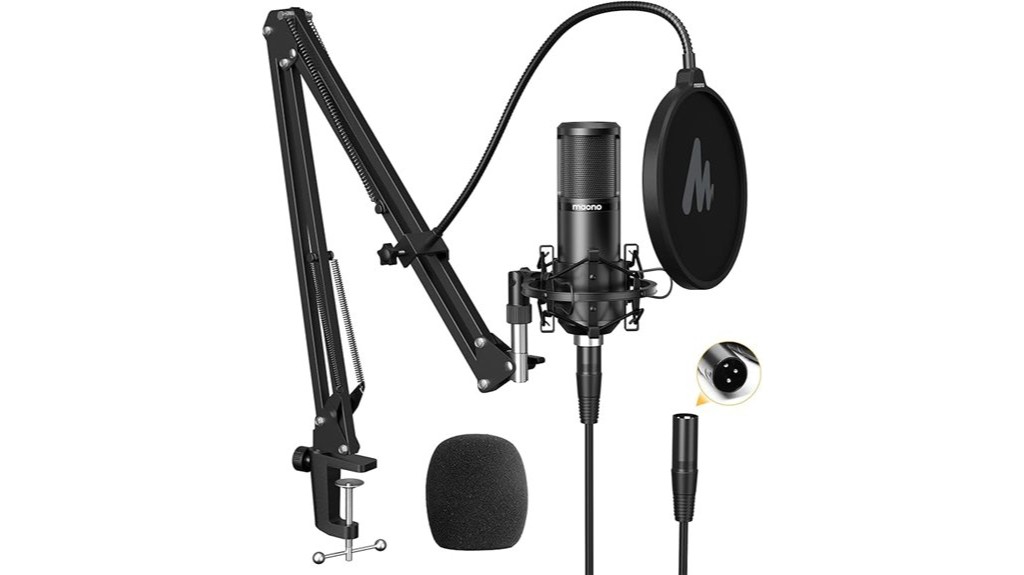
The MAONO XLR Condenser Microphone (PM320S) is an excellent choice for streamers, podcasters, and other content creators seeking a professional-grade microphone that delivers exceptional sound quality. Featuring a large 16mm condenser capsule and custom-engineered diaphragm, this microphone offers an extended frequency response and superior transient response, ensuring crisp, detailed audio capture. The cardioid polar pattern effectively reduces surrounding noise, making it ideal for recording in less-than-ideal acoustic environments. While some users have reported durability concerns with the stand, the microphone’s full-metal construction and shock absorber demonstrate its overall build quality. Overall, the MAONO PM320S provides impressive value, versatility, and sound performance at its price point.
Best For: The MAONO XLR Condenser Microphone (PM320S) is best for streamers, podcasters, and other content creators seeking a professional-grade microphone with excellent sound quality and versatility.
Pros:
- Extended frequency response and superior transient response for crisp, detailed audio
- Cardioid polar pattern effectively reduces surrounding noise
- Full-metal construction and shock absorber for durability
Cons:
- Some issues reported with the durability of the stand
- May require additional acoustic treatment for less-than-ideal recording environments
- 48V phantom power required, which may not be readily available for some users
https://www.amazon.com/dp/B088FH47ZS
Rode PodMic Cardioid Dynamic Broadcast Microphone, Black
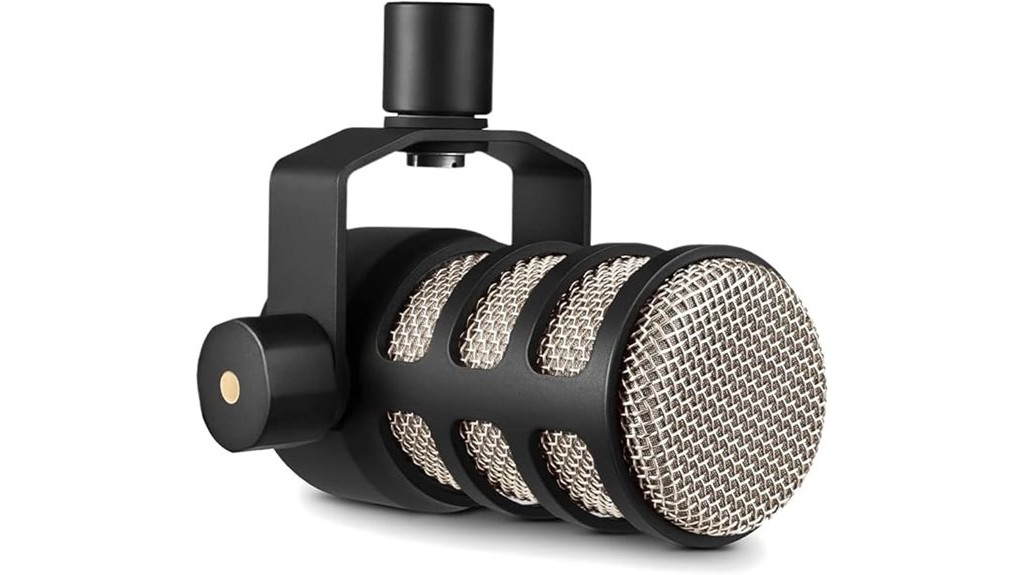
For those seeking a high-quality dynamic microphone optimized for professional podcasting, the Rode PodMic is an excellent choice. Its broadcast-quality sound, rich and balanced, is further enhanced by an internal pop filter and shock mounting to minimize plosives and vibration. Designed for use with the RODECaster Pro, the PodMic delivers exceptional results with any high-quality interface. Its durable metal construction and heavy, solid feel exude quality. However, the microphone’s heft may be a consideration for some users. Overall, the Rode PodMic is a fantastic option for podcasting, streaming, and voiceovers, provided you have a compatible audio interface to harness its full potential.
Best For: Podcasters, streamers, and voice-over artists seeking a high-quality dynamic microphone with professional-grade features.
Pros:
- Great construction and materials
- Easy plug and play
- Excellent sound quality
Cons:
- Heavy
- Sensitive to background noise, recommend using a windscreen
- Requires a good audio interface for optimal performance
https://www.amazon.com/dp/B07MSCRCVK
Factors to Consider When Choosing XLR Microphones
When choosing an XLR microphone, you’ll want to ponder the audio quality and clarity, connectivity and compatibility, noise reduction and pickup pattern, durability and build quality, and ease of use and controls. These factors will help you select the best microphone for your professional audio recording needs. Let’s explore each of these in more detail.
Audio Quality and Clarity
One of the primary factors to ponder when selecting an XLR microphone is its capability to capture audio with exceptional clarity and detail. Microphones with a wide frequency response range, low noise levels, and high signal-to-noise ratios will provide the best results. Additionally, a cardioid polar pattern helps reduce background noise and focuses on the primary sound source, improving overall audio quality. Dynamic microphones often have a more robust sound and can handle higher sound pressure levels without distortion compared to condenser mics. Proper microphone placement, gain staging, and post-processing techniques can also drastically impact the final audio quality. High-quality XLR connections and professional audio interfaces guarantee the recorded signal’s fidelity remains intact.
Connectivity and Compatibility
Connectivity and compatibility are essential considerations when selecting an XLR microphone. You’ll need to confirm the mic’s XLR output is compatible with your audio interface or mixing console. Check for balanced or unbalanced connections. Compatibility with phantom power is also imperative if your gear requires it. Some mics have built-in preamps, so you’ll want to verify they work seamlessly with your setup. Compatibility with your recording software is another factor – some mics have specialized drivers or settings. Assess your current and future needs to pick a mic that’ll integrate smoothly into your workflow. Overlooking connectivity and compatibility can lead to frustrating issues, so do your research upfront.
Noise Reduction and Pickup Pattern
Choosing the right pickup pattern and noise reduction capabilities are essential when selecting an XLR microphone. Cardioid patterns focus on sounds directly in front, minimizing interference from the sides and rear. Dynamic mics generally have better noise rejection than condensers, making them ideal for noisy environments. External windscreens and pop filters can reduce unwanted plosive and sibilant sounds. Noise-cancelling features effectively eliminate background noise for cleaner recordings. Proper microphone technique, like maintaining distance and angle, is imperative for optimal noise rejection and vocal clarity. Consider these factors to guarantee your XLR mic delivers professional-quality audio.
Durability and Build Quality
While durability and build quality may not be the most glamorous factors to ponder, they are essential when selecting an XLR microphone. Metal construction outperforms plastic for longevity, and reinforced mounting points safeguard against physical damage. Secure stand attachments and cables with strain relief guarantee stability and prevent accidental disconnections. Higher-end mics often feature internal shock mounting to absorb vibrations and handling noise. Proper handling and storage in a protective case can extend the lifespan of your XLR microphone. Prioritizing these aspects will confirm your investment stands the test of time and delivers reliable performance for years to come.
Ease of Use and Controls
When selecting an XLR microphone, ease of use and intuitive controls are essential elements to contemplate. Look for microphones with gain knobs, mute buttons, and headphone jacks to simplify operation and monitoring. For hassle-free setup, consider plug-and-play connectivity through XLR interfaces, especially if you’re new to professional audio. Assess the microphone’s ergonomics and weight to guarantee comfortable, fatigue-free use during extended recording sessions. Prioritize versatile mounting options, such as integrated stands or boom arm attachments, for flexible positioning. Ultimately, evaluate the inclusion of accessories like pop filters and shock mounts that can enhance the ease of use and audio quality.
Versatility and Intended Use
Because XLR microphones can be used for a variety of applications, it’s crucial to evaluate their versatility and intended use when making your selection. From podcasting and streaming to voice-over work and instrument recording, XLR mics offer diverse capabilities. Consider the polar pattern, frequency response, and sensitivity of the mic to guarantee it matches your specific needs. Dynamic and condenser XLR mics have distinct characteristics, so choose the type that best suits your application. While XLR mics often provide superior audio quality compared to USB mics, they require additional equipment like an audio interface. Ultimately, assess the mic’s ruggedness and construction to ascertain it can withstand the demands of your use case.
Accessories and Included Items
Many XLR microphones come bundled with accessories that can enhance your audio recording experience. Some include cables, adapters, and connectors, providing a complete setup right out of the box. Accessories like headphone jacks and volume controls can be useful for real-time audio monitoring during recording. Adjustable mic stands or boom arms are common inclusions, offering flexible positioning and placement. The quality and durability of these accessories vary, so consider their specifications when evaluating an XLR microphone package. These added items can substantially/considerably/markedly impact the overall value and utility of the microphone, so it’s important to factor them into your decision.
Value and Budget Considerations
With XLR microphone prices ranging from under $100 to over $1,000, determining a suitable budget is essential for your needs. Higher-priced models often offer superior audio quality, build materials, and features, but budget options can still provide good value. Consider the intended use case, whether it’s home recording, professional podcasting, or live performances, to identify an appropriate price point. Evaluate the cost-to-quality ratio and features of different XLR microphones within your budget to find the best value option. Remember to factor in additional costs like audio interfaces, stands, and accessories when setting your budget for a complete XLR microphone setup.
Frequently Asked Questions
How Do I Set up an XLR Microphone for Optimal Sound Quality?
To set up an XLR microphone for ideal sound quality, start by placing it in the right position – close to the sound source and at the proper angle. Next, connect the microphone to an audio interface using a balanced XLR cable. Adjust the gain on your interface to the appropriate level, and monitor the input signal to verify it’s not clipping. Finally, use acoustic treatment to minimize unwanted reflections and noise in the recording environment.
Can I Use an XLR Microphone With My Smartphone or Tablet?
Yes, you can use an XLR microphone with your smartphone or tablet, but you’ll need an audio interface that converts the XLR signal to a format your device can accept, like USB or Lightning. This will provide better sound quality than your device’s built-in microphone. Just be sure to get a compatible interface and follow the instructions for setting it up with your mobile device.
What Type of Preamp or Interface Do I Need for an XLR Microphone?
To use an XLR microphone with your smartphone or tablet, you’ll need a dedicated preamp or audio interface. These devices convert the microphone’s balanced XLR signal into a format your mobile device can recognize. Look for interfaces with headphone monitoring and iOS/Android compatibility, and you’ll be able to capture professional-quality audio straight to your phone or tablet.
How Do I Maintain and Clean an XLR Microphone for Long-Term Use?
To maintain and clean your XLR microphone for long-term use, start by gently wiping the exterior with a soft, dry cloth. Avoid getting any moisture inside the microphone. You can also use a microphone cleaning spray specifically designed for this purpose. Be sure to store the mic in a protective case when not in use to keep it dust-free. With proper care, your XLR mic can last for years.
Can I Use an XLR Microphone for Live Performances or Stage Work?
XLR microphones can be used for live performances or stage work. They’re designed for professional audio applications and can handle the demands of live settings. Their rugged construction and balanced audio signal make them well-suited for stage use. Just be sure to position the mic properly, use a sturdy mic stand, and connect it to a reliable audio interface or mixing console. With the right setup, an XLR mic can deliver high-quality sound for your live performances.
Conclusion
When choosing an XLR microphone, you’ll want to ponder factors like sound quality, durability, and compatibility. One interesting statistic is that condenser microphones, like the MAONO XLR Condenser Microphone, can capture up to 20kHz of frequency range, providing exceptional audio clarity for professional recordings. Ultimately, the right XLR microphone for you will depend on your specific needs and budget.

Maria is brilliant when it comes to creating beautiful and functional spaces. Maria has an exceptional ability to understand your needs and desires, translating them into tailored solutions that reflect your personality and lifestyle. Whether you’re seeking advice on home decor, looking to upgrade your interior, or seeking inspiration to enhance your quality of life through design, Maria can help you achieve your goals. With Maria by your side, your vision for the perfect home is within reach.
